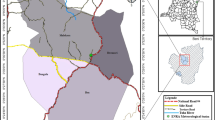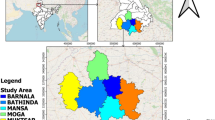Abstract
Climate change–induced precipitation unpredictability has disastrous consequences for closed basins with sensitive hydrological equilibrium. Identifying changes and trends in precipitation characteristics in such catchments is an important step towards minimizing potential disasters. This study explores the precipitation variability of the Konya Closed Basin (Turkey), an over-exploited semi-arid basin. For this purpose, monthly precipitation data for the period 1971–2020 (50 years) of 11 meteorological observation gauges operated by the Turkish State Meteorological Service in the basin were utilized. Precipitation data were examined using two graphical innovative trend methods namely innovative polygon trend analysis (IPTA) and trend polygon star concept (TPSC) approaches. With these methods, periodic features in monthly precipitation data and trend transitions between months can be interpreted visually and linguistically. IPTA and TPSC methods were applied separately to both arithmetic mean data and standard deviation for each month’s precipitation data of 11 stations. A general increasing trend in precipitation was obtained in most of the months for the stations used in the IPTA application. Most of the TPSC arrows, which were distributed throughout all four regions for both the arithmetic mean and standard deviation, were in the I and III regions. Based on the TPSC graphs, the longest transition arrows between two consecutives occurred in the first months of autumn (highly increasing) and summer (highly decreasing) in most of the stations. The results of this study are of great importance for the policies to be sustained regarding the ongoing climate change in the agricultural sector in KCB, which is both a water scarce basin and a region with intensive agricultural activities.







Similar content being viewed by others
Data availability
Data can be provided upon reasonable request.
References
Aawar T, Khare D, Singh L (2019) Identification of the trend in precipitation and temperature over the Kabul River sub-basin: a case study of Afghanistan. Model Earth Syst Environ 5:1377–1394
Acar E, Kankal M, Akçay F, Şan M (2022) Innovative polygon trend analyses with star graph for rainfall and temperature data in agricultural regions of Turkey. Environ Earth Sci 81(23):530
Achite M, Ceribasi G, Wałęga A, Ceyhunlu AI, Elshaboury N, Krakauer N, Hartani T, Caloiero T, Gul S (2023) Analysis of monthly average precipitation of Wadi Ouahrane basin in Algeria by using the ITRA, ITPAM, and TPS methods. Environ Monit Assess 195(5):1–23
Buyukyildiz M (2023) Evaluation of annual total precipitation in the transboundary Euphrates–Tigris River Basin of Türkiye using innovative graphical and statistical trend approaches. Applied Water Science 13(2):38
Caloiero T (2020) Evaluation of rainfall trends in the South Island of New Zealand through the innovative trend analysis (ITA). Theor Appl Climatol 139(1-2):493–504
Ceribasi G, Ceyhunlu AI, Ahmed N (2021) Innovative trend pivot analysis method (ITPAM): a case study for precipitation data of Susurluk Basin in Turkey. Acta Geophys 69(4):1465–1480
Chowdhury RK, Beecham S (2010) Australian rainfall trends and their relation to the southern oscillation index. Hydrol Process: Int J 24(4):504–514
Dabanlı İ (2019) A climate change impact: variation in precipitation patterns, and increased drought risk in Turkey. Sakarya Univ J Sci 23(2):193–202
Demir İ (2008) PRECIS Bölgesel İklim Modeli ile Türkiye için İklim Öngörüleri,”IV. Atmosfer Bilimleri Sempozyumu, Bildiriler Kitabı, İstanbul (in Turkish)
Demir V (2022) Trend analysis of lakes and sinkholes in the Konya Closed Basin, in Turkey. Nat Hazards 112(3):2873–2912
Demir V, Keskin AÜ (2020) Water level change of lakes and sinkholes in Central Turkey under anthropogenic effects. Theor Appl Climatol 142(3–4):929–943. https://doi.org/10.1007/S00704-020-03347-5/FIGURES/10
Demir V, Uray E, Orhan O, Yavariabdi A, Kusetogullari H (2021) Trend analysis of ground-water levels and the effect of effective soil stress change: the case study of Konya Closed Basin. Avrupa Bilim ve Teknoloji Dergisi 24:515–522
Duygu MB, Kirmencioglu B, Aras M (2017) Essential tools to establish a comprehensive drought management plan - Konya Basin Case study. Turk J Water Sci Manag 1(1):54–70
Erdoğan S, Ulukavak M, Yılmaz M (2022) Precipitation trends in Turkey (1969–2018): a spatiotemporal analysis. Idojaras 126(3):335–353. https://doi.org/10.28974/IDOJARAS.2022.3.4
Hayelom B, Chen Y, Marsie Z, Negash M (2017) Temperature and precipitation trend analysis over the last 30 years in Southern Tigray Regional State. Ethiopia Preprints 2017:2017020014. https://doi.org/10.20944/preprints201702.0014.v1
Hırca T, Eryılmaz Türkkan G, Niazkar M (2022) Applications of innovative polygonal trend analyses to precipitation series of Eastern Black Sea Basin, Turkey. Theor Appl Climatol 147(1-2):651–667
Hussain F, Ceribasi G, Ceyhunlu AI, Wu RS, Cheema MJM, Noor RS, Anjum MN, Azam M, Afzal A (2022a) Analysis of precipitation data using innovative trend pivot analysis method and trend polygon star concept: a case study of Soan River Basin, Potohar Pakistan. J Appl Meteorol Climatol 61(12):1861–1881
Hussain F, Wu RS, Nabi G, Noor RS, Anjum MN, Azam M, Afzal A (2022b) Analysis of temperature data using the innovative trend pivot analysis method and trend polygon star concept: a case study of Soan River Basin, Potohar, Pakistan. Pure Appl Geophys 180(1):475–507
Kılıç N, Acar B (2021) Temperature-rainfall trend analysis relationships with agro-water productivity at semi-arid Konya region of Turkey. Ann Univ Craiova 26(62):5–12. https://doi.org/10.52846/bhfe.26.2021.01
Koycegiz C, Buyukyildiz M (2019) Temporal trend analysis of extreme precipitation. Pamukkale Univ J Eng Sci 25(8):956–961. https://doi.org/10.5505/PAJES.2019.86658
Koycegiz C, Buyukyildiz M (2020) Determination of change point and trend analysis of annual temperature data in Konya Closed Basin (Turkey). Niğde Ömer Halisdemir Üniversitesi Mühendislik Bilimleri Dergisi 9(1):393–404
Koycegiz C, Buyukyildiz M (2022a) Investigation of precipitation and extreme indices spatiotemporal variability in Seyhan Basin, Turkey. Water Supply 22(12):8603–8624
Koycegiz C, Buyukyildiz M (2022b) Investigation of spatiotemporal variability of some precipitation indices in Seyhan Basin, Turkey: monotonic and sub-trend analysis. Nat Hazards 116:2211–2244
Koycegiz C, Sen OL, Buyukyildiz M (2023) An analysis of terrestrial water storage changes of a karstic, endorheic basin in central Anatolia, Turkey. Ecohydrol Hydrobiol. https://doi.org/10.1016/J.ECOHYD.2023.07.002
Leech NL, Barrett KC, Morgan GA (2005) SPSS for intermediate statistics: use and interpretation, 2nd edn. Taylor & Francis
Nisansala WDS, Abeysingha NS, Islam A, Bandara AMKR (2020) Recent rainfall trend over Sri Lanka (1987–2017). Int J Climatol 40(7):3417–3435
Nobre GG, Jongman B, Aerts JCJH, Ward PJ (2017) The role of climate variability in extreme foods in Europe. Environ Res Lett 12(8):084012
Onyutha C (2016a) Identification of sub-trends from hydro-meteorological series. Stoch Env Res Risk Assess 30(1):189–205
Onyutha C (2016b) Statistical analyses of potential evapotranspiration changes over the period 1930–2012 in the Nile River riparian countries. Agric For Meteorol 226:80–95
Onyutha C (2021) Graphical-statistical method to explore variability of hydrological time series. Hydrol Res 52(1):266–283
Orhan O, Yakar M, Ekercin S (2020) An application on sinkhole susceptibility mapping by integrating remote sensing and geographic information systems. Arab J Geosci 13:886
Saplıoğlu K, Güçlü YS (2022) Combination of Wilcoxon test and scatter diagram for trend analysis of hydrological data. J Hydrol 612:128132
Şen Z (2012) Innovative trend analysis methodology. J Hydrol Eng 17(9):1042–1046
Şen Z (2021) Conceptual monthly trend polygon methodology and climate change assessments. Hydrol Sci J 66(3):503–512
Şen Z (2022a) Crossing empirical trend analysis (CETA) at risk levels in hydro-meteorological time series. Theor Appl Climatol 148(1-2):145–163
Şen Z (2022b) İklim değişikliği ve Türkiye. Çevre Şehir ve İklim Dergisi 1(1):1–19 (in Turkish)
Şen Z, Şişman E, Dabanli I (2019) Innovative polygon trend analysis (IPTA) and applications. J Hydrol 575:202–210
Sezen C (2023) A new wavelet combined innovative polygon trend analysis (W-IPTA) approach for investigating the trends in the streamflow regime in the Konya Closed Basin, Turkey. Theor Appl Climatol 151(3-4):1523–1565
Swain S, Taloor AK, Dhal L, Sahoo S, Al-Ansari N (2022) Impact of climate change on groundwater hydrology: a comprehensive review and current status of the Indian hydrogeology. Applied Water Science 12(6):120
SYGM (2016) T.C. Orman ve Su İşleri Bakanlığı Su Yönetimi Genel Müdürlüğü (SYGM) Taşkın ve Kuraklık Yönetimi Dairesi Başkanlığı, İklim Değişikliğinin Su Kaynaklarına Etkisi Projesi, Proje Nihai Raporu, Ankara.
SYGM (2019) Konya Havzası Taşkın Yönetim Planı Stratejik Çevresel Değerlendirme Taslak Kapsam Belirleme Raporu, Konya ve Van Gölü Havzaları Taşkın Yönetim Planının Hazırlanma Projesi.
SYGM (2020a) T.C. Orman ve Su İşleri Bakanlığı Su Yönetimi Genel Müdürlüğü (SYGM) Konya Kapalı Havzası Taşkın Yönetim Planı Yönetici Özeti. Ankara. https://www.tarimorman.gov.tr/SYGM/Belgeler/Ta%C5%9Fk%C4%B1n%20Y%C3%B6netim%20Planlar%C4%B1/Konya_Yonetici_Ozeti.pdf) (in Turkish)
TEMA-WWF Türkiye (2015) İklim Değişikliğinin Yerel Etkileri Raporu. https://cdn-tema.mncdn.com/Uploads/Cms/iklim-degisiklik-yerel-etkileri-rapor-kitapcigi.pdf
Wang Y, Xu Y, Tabari H, Wang J, Wang Q, Song S, Hu Z (2020) Innovative trend analysis of annual and seasonal rainfall in the Yangtze River Delta, eastern China. Atmos Res 231:104673
WWF (2010) Türkiye’nin Yarınları Projesi Sonuç Raporu. Doğal Hayatı Koruma Vakfı, Türkiye. https://wwftr.awsassets.panda.org/downloads/wwf__turkiyenin_yarinlari_projesi_final_raporu.pdf (in Turkish)
WWF (2014) Konya’da Suyun Bugünü Raporu. Doğal Hayatı Koruma Vakfı, Türkiye. https://wwftr.awsassets.panda.org/downloads/konya_da_suyun_bugnu_raporu.pdf (in Turkish)
Yazici B, Taner H (2023) Water reuse in agriculture: a case study in Konya Closed Basin. Water Supply 23(3):1106–1114. https://doi.org/10.2166/WS.2023.039
Acknowledgements
We would like to thank the Turkish State Meteorological Service for providing the precipitation data.
Author information
Authors and Affiliations
Contributions
C.K. Conceptualization, investigation, data collection and analysis, methodology, interpretation of the results, visualization, writing, and reviewing the whole content. M.B. Conceptualization, supervision, interpretation of the results, visualization, writing, and reviewing the whole content.
Corresponding author
Ethics declarations
Ethics approval
Not applicable.
Conflict of interest
The authors declare no conflict of interest.
Additional information
Publisher’s Note
Springer Nature remains neutral with regard to jurisdictional claims in published maps and institutional affiliations.
Rights and permissions
Springer Nature or its licensor (e.g. a society or other partner) holds exclusive rights to this article under a publishing agreement with the author(s) or other rightsholder(s); author self-archiving of the accepted manuscript version of this article is solely governed by the terms of such publishing agreement and applicable law.
About this article
Cite this article
Koycegiz, C., Buyukyildiz, M. Applications of innovative polygon trend analysis (IPTA) and trend polygon star concept (TPSC) methods for the variability of precipitation in Konya Closed Basin (Turkey). Theor Appl Climatol 155, 2641–2656 (2024). https://doi.org/10.1007/s00704-023-04765-x
Received:
Accepted:
Published:
Issue Date:
DOI: https://doi.org/10.1007/s00704-023-04765-x




